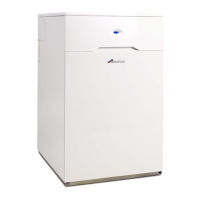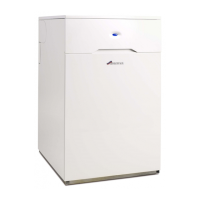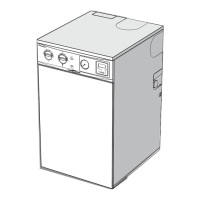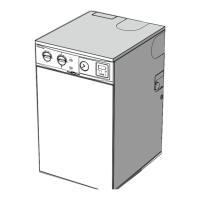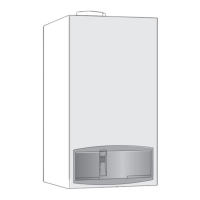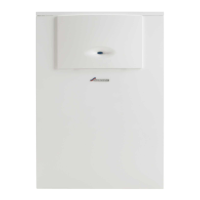Pre-Installation
Greenstar Heatslave II
ErP -
6 720 813 344 (2014/09) 15
Fig. 14 Disposal into a rainwater down pipe
Where the pipe terminates over an open drain or gully, the pipe should
terminate below the grating level, but above water level, in order to
minimise “wind chill” at the open end.
The use of a drain cover (such as those used to prevent blockage by
leaves) may offer further protection from wind chill.
Pipe drainage will be improved if the end is cut at 45° as opposed to a
straight cut.
Fig. 15 External disposal
Fig. 16 Condensate pump to external disposal
4.5.3 Soak away
• The condensate drainage pipe may be run above or below the ground
to the soak away. The examples shown on this page run above
ground.
• The soak away must use a 100mm Ø plastic tube with two rows of
three 12mm holes on 25mm centres and 50mm from the bottom of
the tube. The holes must face away from the house.
• The tube must be filled with and surrounded by at least 100mm of
limestone chippings to a depth of 400mm.
In situations where there are likely to be extremes of temperature or
exposure, the use of a proprietary trace-heating system for external pipe
work, incorporating an external frost thermostat, should be considered.
If such a system is used, the requirement to use 32mm pipe does not
apply. However, all other guidance above and the instructions for the
trace heating system, should be closely followed.
Fig. 17 Disposal to a soakaway
Condensate drainage pipe can be run above or below
ground.
Continued - Key to condensate illustrations
16 100mm Ø minimum plastic pipe
17 Drainage holes
18 Limestone chippings (25kg min.)
19 Bottom of sealed tube
15
14
9
11
12
13
10
2
1
67206813284-04.2Wo
21.5mm Ø min
Minimum hole size for the condensate soak away must be
400mm deep by 300mmØ .
NOTICE: Unheated internal areas.
▶ Internal pipe runs in unheated areas such as lofts,
basements and garages should be treated as
external runs and insulate as necessary.

